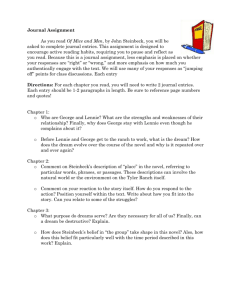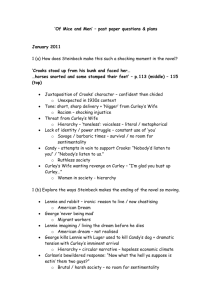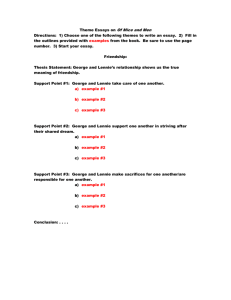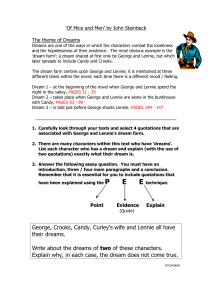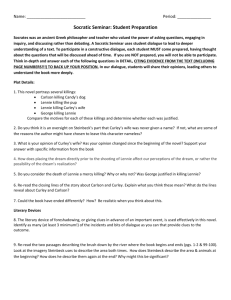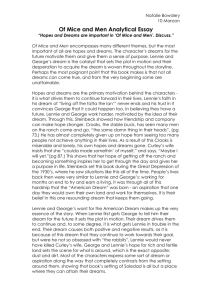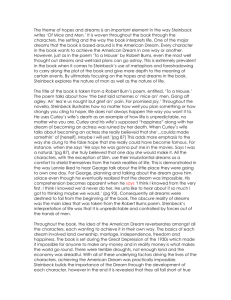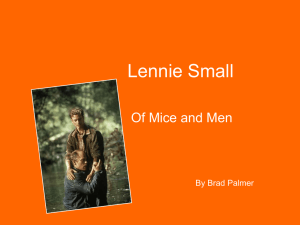The theme of hopes and dreams is an important
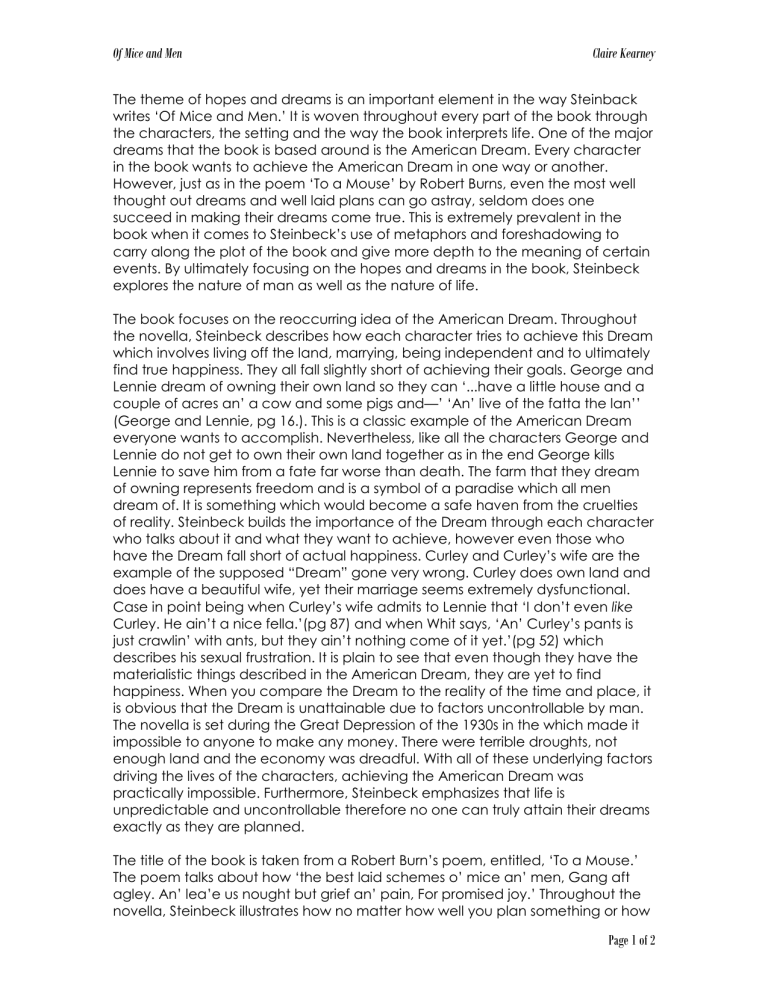
Of Mice and Men Claire Kearney
The theme of hopes and dreams is an important element in the way Steinback writes ‘Of Mice and Men.’ It is woven throughout every part of the book through the characters, the setting and the way the book interprets life. One of the major dreams that the book is based around is the American Dream. Every character in the book wants to achieve the American Dream in one way or another.
However, just as in the poem ‘To a Mouse’ by Robert Burns, even the most well thought out dreams and well laid plans can go astray, seldom does one succeed in making their dreams come true. This is extremely prevalent in the book when it comes to Steinbeck’s use of metaphors and foreshadowing to carry along the plot of the book and give more depth to the meaning of certain events. By ultimately focusing on the hopes and dreams in the book, Steinbeck explores the nature of man as well as the nature of life.
The book focuses on the reoccurring idea of the American Dream. Throughout the novella, Steinbeck describes how each character tries to achieve this Dream which involves living off the land, marrying, being independent and to ultimately find true happiness. They all fall slightly short of achieving their goals. George and
Lennie dream of owning their own land so they can ‘...have a little house and a couple of acres an’ a cow and some pigs and—’ ‘An’ live of the fatta the lan’’
(George and Lennie, pg 16.). This is a classic example of the American Dream everyone wants to accomplish. Nevertheless, like all the characters George and
Lennie do not get to own their own land together as in the end George kills
Lennie to save him from a fate far worse than death. The farm that they dream of owning represents freedom and is a symbol of a paradise which all men dream of. It is something which would become a safe haven from the cruelties of reality. Steinbeck builds the importance of the Dream through each character who talks about it and what they want to achieve, however even those who have the Dream fall short of actual happiness. Curley and Curley’s wife are the example of the supposed “Dream” gone very wrong. Curley does own land and does have a beautiful wife, yet their marriage seems extremely dysfunctional.
Case in point being when Curley’s wife admits to Lennie that ‘I don’t even like
Curley. He ain’t a nice fella.’(pg 87) and when Whit says, ‘An’ Curley’s pants is just crawlin’ with ants, but they ain’t nothing come of it yet.’(pg 52) which describes his sexual frustration. It is plain to see that even though they have the materialistic things described in the American Dream, they are yet to find happiness. When you compare the Dream to the reality of the time and place, it is obvious that the Dream is unattainable due to factors uncontrollable by man.
The novella is set during the Great Depression of the 1930s in the which made it impossible to anyone to make any money. There were terrible droughts, not enough land and the economy was dreadful. With all of these underlying factors driving the lives of the characters, achieving the American Dream was practically impossible. Furthermore, Steinbeck emphasizes that life is unpredictable and uncontrollable therefore no one can truly attain their dreams exactly as they are planned.
The title of the book is taken from a Robert Burn’s poem, entitled, ‘To a Mouse.’
The poem talks about how ‘the best laid schemes o’ mice an’ men, Gang aft agley. An’ lea’e us nought but grief an’ pain, For promised joy.’ Throughout the novella, Steinbeck illustrates how no matter how well you plan something or how
Page 1 of 2
Of Mice and Men Claire Kearney
strongly you cling to hope, life does not always happen the way you want it to.
He uses Curley’s wife’s death as an example of how life is unpredictable, no matter who you are. Curley and his wife’s supposed “happiness” along with her dream is ruined by her death. When Curley’s wife talks about becoming an actress she really believed that she‘...coulda made somethin’ of [herself]. Maybe
I will yet.’(pg 87) This adds more emphasis to the way she clung to the false hope that she really could have become famous, for instance when she says ‘He says he was gonna put me in the movies. Says I was a natural.’(pg 87). She truly believed that one day she would make it, but as in the poem, this was not the case. All the characters, with the exception of Slim, use their insubstantial dreams as a comfort, this is demonstrated in the way Lennie likes to hear George talk about the little place they are going to own one day. For George, planning and talking about the dream gives him solace even though he eventually realizes that the dream is impossible when he says ‘I think I knowed from the very first. I think I knowed we’d never do her. He usta like to hear about it so much I got to thinking maybe we would.’ (pg 93). Consequently all dreams were destined to fail from the beginning of the book, shown through metaphors and foreshadowing. This is the main idea that was taken from the Robert Burns poem, that Steinbeck’s interpretation of life was that it is unpredictable and controlled by forces out of the hands of men.
The use of metaphors and foreshadowing throughout the book emphasizes the way that dreams are really only dreams, which is very different to the reality of life. The mouse and puppy that Lennie kill are both metaphors for the way in which Curley’s wife is murdered. ‘Lennie never done it in meanness’ (pg 93) describes how Lennie did not know his own strength and therefore did not mean to hurt anybody. After talking about their dream, George tells Lennie to ‘hide in the brush’ (pg 17) if he gets into any trouble, this is a major way of foreshadowing that something is bound to go wrong that will stop their dream from coming true.
Candy’s dog’s death is parallel to Lennie’s fate, which in turn is a metaphor for the fate of the dreams of all the characters. The way Carlson kills the dog shows that those who are stronger will dispose of those who are weaker, in the same way that the bigger forces of life will dispose of the fragile dreams of man. All of these things relate to the way that the metaphors laced throughout the crucial plot points of the novella to help the reader understand Steinbeck’s view on the dreams of the characters.
The way the characters each use their hopes and dreams to comfort them through reality is an important motif when it comes to the way Steinbeck describes the nature of men and their ‘well laid schemes’. The American Dream is the main dream that the characters all aspire to achieving. They each want to find their own piece of happiness in the cruel reality of the world. The poem from which the book takes it title has an obvious influence of these ideals. Life does not always happen as it is planned no matter what you do or who you are.
Through metaphors, Steinbeck shows that fate and destiny are very different to dreams and the outcomes of life. Man’s fate is guided by bigger forces, therefore dreams, even though they may comfort you in the present, only give false hope as to what you can really achieve.
